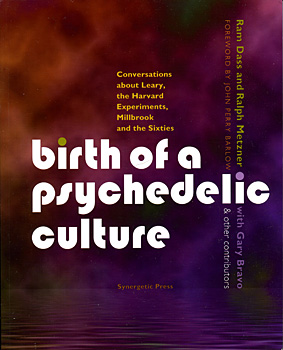
BLURBS #
"An enchanted treasure chest, overflowing with insightful new dialogues, fascinating anecdotes, valuable historical accounts and other never-before-published material about the origins of modern psychedelic culture, by the people who helped to create it. Difficult to put down, this exciting book enriched my understanding of how Harvard's legendary psychedelic research team turned on the world."-- David Jay Brown, co-author of Conversations on the Edge of the Apocalypse & Mavericks of Medicine
"Ram Dass, Timothy Leary and Ralph Metzner dedicated their knowledge, passion and physical lives to a detailed study of human physio-psychology-spirit. This book shows how their rigorous use of scientific method, combined with courageous personal experience, astounded and educated millions."
-- John Allen, inventor of Biosphere 2 Project; Chairman, Global Ecotechnics
"Someday, when people speak of the Psychedelic Age as they do of the Atomic Era, the Space Age, and the Personal Computer Revolution, the period 1960-1966 at Harvard's Center for Research in Personality and New York's Millbrook Estate will be central to the conversation. PhDs Leary, Alpert / Ram Dass and Metzner revolutionized an Ivy League psychology department with experimental shamanism during the height of the Cold War era and followed that up by launching a version of Hesse's utopian Castalia Foundation in the guise of a psychedelic commune. They devised novel experiments to study the transformation of the human mind altered by psychedelic drugs available for the first time in history in precise doses. Beginning with psilocybin synthesized from so-called magic mushrooms, they graduated to LSD, the most powerful mind drug ever discovered. They adopted a timeless religious text, the Tibetan Book of the Dead, into a manual for navigating the processes of death and rebirth (The Psychedelic Experience), and produced the first journal ( Psychedelic Review ) solely devoted to this emergent field. They introduced the highly useful concept of "set and setting," and published scores of papers documenting and analyzing sessions ("trips") conducted with graduate students, prisoners, theologians, intellectuals, artists, "beat" writers and jazz musicians. Transformed from Organization Man styled button-down neuronauts into new wave shamans, these three academics profoundly influenced Western culture despite a relentless push-back by hostile educators, sheriffs and drug agents looking for easy targets, a media that delighted in mocking them, and ultimately the full weight of the United States government challenged by a turned-on youth culture that refused to march in lockstep during the waging of a disastrous war."
-- Michael Horowitz, co-author of The High Times Encyclopedia of Recreational Drugs; co-founder, director of Fitz Hugh Ludlow Memorial Library


